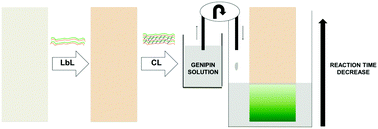Chitosan–alginate multilayered films with gradients of physicochemical cues†
Abstract
Tissues presenting continuous variations of properties in one direction have inspired the development of functional graded materials. In this work, we developed a new facile method for the development of continuous gradients in chitosan (CHIT) and alginate (ALG) polyelectrolyte multilayers (PEMs) obtained layer-by-layer based on the gradual dipping of CHIT/ALG coated glass slides in genipin solution. Stiffness gradients were produced in the cm scale by varying the reaction time with genipin. Quartz crystal microbalance, colorimetric measurements, trypan blue assay, attenuated total reflection-Fourier transform infrared spectroscopy, swelling ability, water contact angle and dynamic mechanical analysis (DMA) were used to find suitable conditions for the stiffness gradient. The PEMs can be successfully built up and cross-linked with genipin to yield surfaces with uniform physicochemical properties or with gradients of different physicochemical properties. It was found that a large reduction in the hydrophobic nature of the CHIT/ALG PEMs could be produced with higher cross-linking reaction times, regardless of the decrease in their swelling ability. Moreover, the mechanical properties were evaluated using an innovative and non-conventional DMA to monitor the cross-linking reaction in situ. The results confirm an enhancement on the tensile storage modulus with increasing reaction times from 60 to 140 MPa. In another original DMA testing protocol the local compression storage modulus was also measured directly on the films along the stiffness gradient, with results consistent with the tensile tests obtained on the freestanding membranes with different cross-linking degrees. The in vitro biological performance demonstrates that L929 adhered and spread more in the stiffer regions. This work demonstrates the versatility and feasibility of the LbL methodology to generate functional biomimetic surfaces with tuned mechanical and physicochemical properties, which hold great promise for the study of cell–substrate interactions.



 Please wait while we load your content...
Please wait while we load your content...